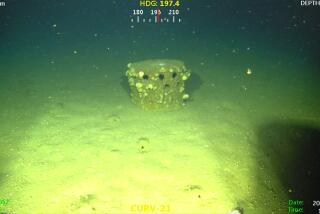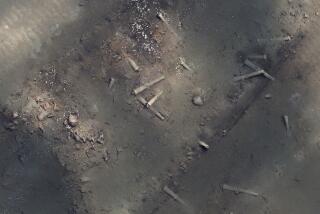U-boat sighting
At this depth, the sun barely penetrates, although exactly how deep is still secret. In the murky ocean water, even the brightest lights allow visibility of only 15 or 20 feet. As diver Kendall Raine recounted it, he kept getting more and more excited: First his eyes lighted on the shadowy, encrusted shape of a cylindrical hull, then a submarineâs characteristic diving planes, then a conning tower.
âWell, that about nails it,â he said to himself, his voice echoing in his own ears in the squeaky pitch of Donald Duckâs, thanks to helium mixed into the breathing gas that allows tech divers to survive the extreme depths that can be found off San Pedro Bay.
After 82 years, the German submarine UB-88 had been discovered.
The 182-foot UB-88 had traveled half the world to reach the bottom of the sea. No other German U-boat is thought to rest off the West Coast of the U.S., according to the underwater archeologists who pursued the wreck.
Few vessels in history chalked up a record like UB-88âs -- having served against the Allies in wartime and then for them in peacetime.
Under commission of the German Navy in World War I, UB-88 sank more than a dozen Allied ships in the Atlantic. After the war, it became a laboratory for U.S. Navy technicians to study the workings of an enemy submarine.
Later, it became a traveling tourist attraction in a campaign to sell victory bonds and pay off American war debts. Finally, UB-88 was towed out of San Pedro Harbor on Jan. 3, 1921, and sunk in a Navy live-fire exercise.
The Los Angeles Times reported from the scene that the âformer Hun sea scourgeâ went down six miles from the harbor âsomewhere off San Pedro light.â
In recent years, the exact resting place of UB-88 has attracted wreck divers in the region, and there have been rumors of its location. But the first confirmation occurred when Southern California fisherman and nondiver Gary Fabian lowered a video camera over the side of his boat in July and filmed it.
With friend Ray Arntz, a long-time dive boat skipper, Fabian spent more than a year in the search, using old Navy ship logs and high-tech sea-floor maps. Fabian first developed an interest in âunderwater structuresâ because they attract fish.
When he heard the story of UB-88, his interest became an obsession. He investigated about 50 targets in the deep waters, most of them piles of rocks, before achieving success.
The team enlisted Raine and partner John Walker, respected tech divers, to confirm and photograph the wreck. Raineâs reaction at first sight of the old warship? âA thrill. It was an act of discovery and fulfillment.â
Team members vow to maintain secrecy about its location. They say UB-88 may contain an unexploded scuttling charge and they do not want to encourage divers at depths far below the recreational scuba limit of 130 feet.
Nautical charts show the seabed in this vicinity drops from 70 feet to more than 2,500 feet. Besides, the team says souvenir hunters are unlikely to find anything in the wreck because UB-88 was stripped before being sunk.
More details are at www.ub88.org.
More to Read
Sign up for Essential California
The most important California stories and recommendations in your inbox every morning.
You may occasionally receive promotional content from the Los Angeles Times.










